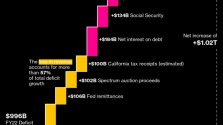When the rate at which they borrow money to spend on the military industrial complex grows fast enough, the GDP growth from that outpaces the declines in other sectors. That's what this is. If you subtract the contributions to GDP from that activity, the economy is shrinking.Not sure how the US can keep borrowing forever. Basically, after the end of pandemic spending, the spending should have fallen much faster and deeper. In addition, revenue is down almost 10% which points to a very weak economy even though inflation is climbing but GDP number grows much faster than expected even though electricity usage is down.
The shortfall for the fiscal year that ended Sept. 30 was $1.7 trillion, equivalent to 6.3% of gross domestic product, according to US Treasury data released Friday. That’s the third-largest on record and compares with $1.38 trillion in the prior 12 months, or 5.4% of GDP.
Excluding the accounting effects of President Joe Biden’s plan for student-loan forgiveness, which was struck down by the Supreme Court, the widening of the deficit was much more pronounced: it effectively doubled, to about $2 trillion.
Overall, spending dropped 2.2% from the prior year to $6.13 trillion, about 22.8% of GDP.
The weighted average interest rate for total outstanding debt by the end of September was 2.97%, the highest since 2011 and up from 2.07% a year before, Treasury data show. That could rise further, as yields on Treasury securities have jumped in recent weeks to the highest in more than 15 years.
Revenue for the fiscal year slid by 9.3% to $4.44 trillion, equivalent to about 16.5% of GDP, down from 19.3%. One major reason: A surging stock market prior to 2022 boosted capital gains revenues in the previous year, leading to a relatively worse tax take this year.
You are using an out of date browser. It may not display this or other websites correctly.
You should upgrade or use an alternative browser.
You should upgrade or use an alternative browser.
American Economics Thread
- Thread starter Bernard
- Start date
They missed "Onlyfans content creator"
Bruh who let Elon Musk rename the country?Imagine If such unfortunate situation is happening in Xina. All the Xina collapse b.s. will spring up like shrooms
One of the fastest growing segments of America’s homeless population is people who live in their cars, R.V.s or other vehicles.
In many ways, it’s a sign of the worsening squeeze on the nation’s middle class. Compared with those living in tents and shelters, the so-called mobile homeless are more likely to have jobs or to be actively looking for work, a U.C.L.A. study found. Many lost their homes after being unable to afford rent or their mortgage, and had to move into their most valuable possession.
In many ways, it’s a sign of the worsening squeeze on the nation’s middle class. Compared with those living in tents and shelters, the so-called mobile homeless are more likely to have jobs or to be actively looking for work, a U.C.L.A. study found. Many lost their homes after being unable to afford rent or their mortgage, and had to move into their most valuable possession.
US is the only country that will never default at this time. Because all its debt is denominated in US dollars which they can print at will. They will never default. What could happen is US continues to make more and more debt which will cause more inflation and then Fed will be forced to raise its interest rate too high to cause a recession. US will pay for its high debt by inflation. Not by default.I am still waiting for that US debt default to happen. The US government already stole the Russian reserves stored abroad but that will only take them so far.

